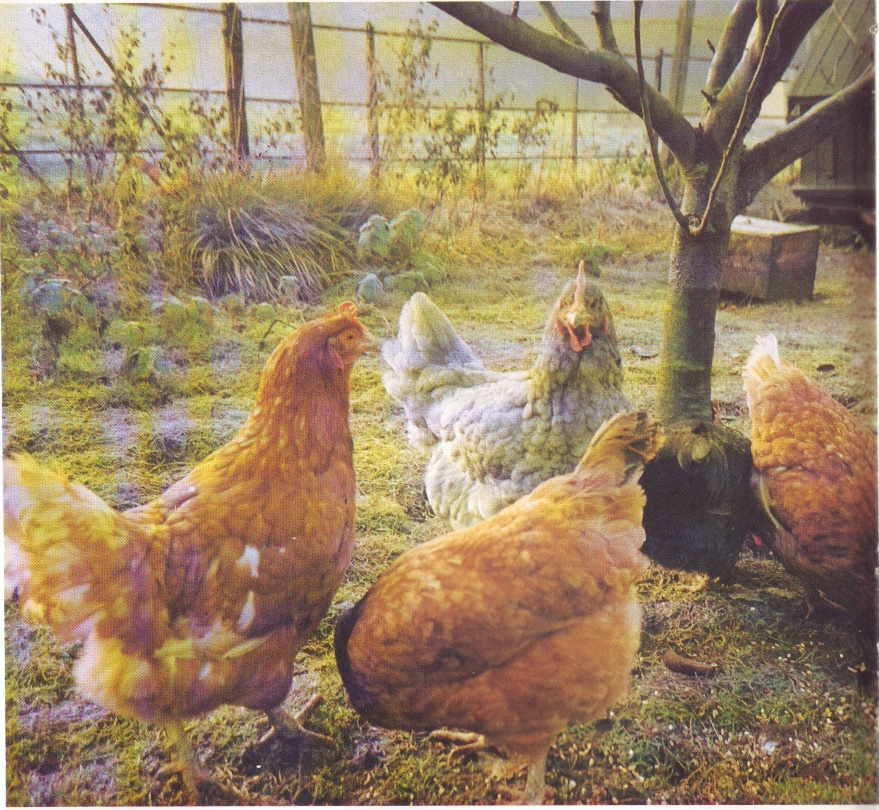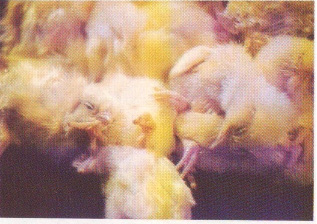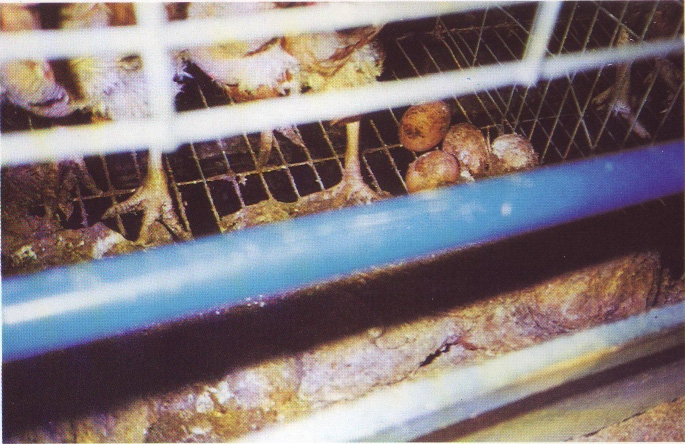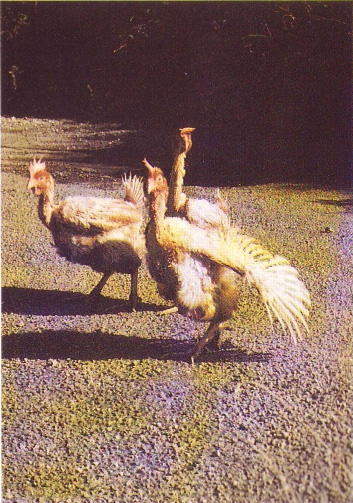TODAY'S FARM ANIMALS
THE INSIDE STORY
Page e
THE BATTERY HEN
Battery cage conditions do nothing to destroy 'ancestral memory':
'Chickens in battery cages which have wire floors., can often be seen to go through all the motions of having a dust-bath. If such dust-deprived birds are eventually given access to something in which they have a real dust-bath ...they go in for a complete orgy of dust-bathing. They do it over and over again, apparently making up for lost time...'
Through Our Eyes Only, Dr Marian Stamp Dawkins, Department of Zoology, Oxford University (W. H.Freeman, Spektrum 1993).
 Chickens' Lib hens. All the brown ones were rescued in featherless
condition from the cruel confinement of battery cages.
Chickens' Lib hens. All the brown ones were rescued in featherless
condition from the cruel confinement of battery cages.
THE TRUE LIFE STORY OF THE BATTERY HEN
Day One
Chicks are sexed at high speed, and the males killed. (Laying hens have been genetically selected for high egg production but not for high meat yield, so the males of this strain are considered uneconomic to rear. This culling at the hatchery stage applies to all systems, including free range.) Many 'Easter' chicks die a slow and distressing death in the gas-filled 'rubbish bins' into which they are tossed.
 Exterminated day-old chicks. Photo: Bob Holt |
The young birds are reared in special cages, or on deep litter. Those 'lucky' ones initially allowed their freedom in deep litter systems suffer a cruel shock when, at around 18 weeks, they're imprisoned in battery cages - for life.
Debeaking/Beaktrimming
Some chicks are debeaked, a mutilation involving partial amputation of the beak with a red hot blade. This is to minimise cannibalism in later life and can result in life-long pain.
A Year in Cages
Most battery hens spend around one year in laying cages before going for slaughter. Some are force-moulted in readiness for a second year of incarceration. For their entire lives they stand or crouch on bare sloping wire, often suffering severe damage to feet and claws, always enduring discomfort and distress. Cages are stacked three, four or five tiers high (sometimes higher) and a typical cage for five hens measures 18" by 20" (45 by 50 cms).
The Cruelty of Cages
In their natural state hens are active from dawn to dusk, walking, running, pecking and scratching in the ground for food, dust-bathing and nest-building - all behavioural patterns denied to the battery hen. Severely frustrated, caged hens turn to pecking at each other.
The Laying Ordeal - What Price Those 'Farm Fresh' Eggs?
Today's hybrid hens lay five to six times a week. Battery hens become highly stressed and aggressive during the pre-laying period because of lack of privacy and nesting materials. Konrad Lorenz, the renowned animal behaviourist, wrote:
'For the person who knows something about animals it is truly heart-rending to watch how a chicken tries again and again to crawl beneath her fellow-cage mates, to search there in vain for cover.'
When an egg is produced, the vent becomes distended, red and moist, attracting the attention of bored and frustrated birds. Vent pecking can occur, and even lead to cannibalism. In cages there is no escape!
Diseases of Intensification - Cages Promote Suffering
Many diseases and injuries go unnoticed in the gloomy, overcrowded cages. Birds in the top and lowest cages suffer most from neglect, being hard to see. Impacted eggs, prolapses and disorders of kidneys and liver plague battery hens, and Marek's disease (a form of cancer) takes its toll. Often, birds reach the point of death before farmers notice anything amiss. Worse, dead hens (such as those in the photo below) are left in cages for long periods while 'farm fresh' eggs roll past or lodge against the corpses.

Battery hens with a collection of 'farm fresh' eggs building up behind their two decaying companions. Photo: Hillside Animal Sanctuary.
Many spent hens have malignant tumours. In the dimly-lit cage conditions they're ignored, and many sick birds are loaded onto lorries to travel to slaughter. Could cancerous birds reach the consumer?
Brittle and Broken Bones
Cage conditions result in hens with bones so brittle they snap when catchers wrench them from the cages. An ex-poultry worker gave the following description of his daily tasks and the catching process:
'One of my jobs was removing dead birds. There was never any shortage. Due to poor light the bottom two tiers of cages were in darkness, and it was impossible to see if the birds were still alive. When the cacasses were removed it was often a matter of a skeleton head and a few bones. I once took part in the clearance of a ten thousand bird shed. Other lads were brought in from local farms and the torture commenced. l recall being shouted at for my gentleness. Birds were dragged from the cages by their legs. Four birds were carried in each hand end down, down the shed to the door. The noise was deafening, the smell was putrid. Legs, wings and necks were snapped without concern. As l now look back, the whole system is incredibly cruel. After saying all this, this particular farm was good as far as battery farms go. The floors were swept daily and precautions taken against disease and pests... l gave up work in the poultry industry after bad dreams at night'
Research at Bristol University has indicated that a massive 24% of battery hens suffer broken bones during catching.
Transport to Slaughter
Millions of battery hens travel great distances to slaughter, since only a
handful of processing plants specialise in the killing of 'spent' hens. Often nearly featherless, they may endure journeys in near-freezing
conditions while hot weather can cause death from heat distress.
 Often nearly featherless 'spent' hens suffer greatly during transport to slaughter. These three were spared this fate. Here they are seen
enjoying sunshine for the very first time. Notice how one is spreading her wing, to feel the sun's warm rays. Photo: Dave Clegg
Often nearly featherless 'spent' hens suffer greatly during transport to slaughter. These three were spared this fate. Here they are seen
enjoying sunshine for the very first time. Notice how one is spreading her wing, to feel the sun's warm rays. Photo: Dave Clegg
Slaughter
Most poultry are killed by electric stunning plus neck cutting. UK law requires that the birds are rendered unconscious by the electric stun until death occurs through blood loss (exemptions exist for Jewish and Muslim methods). Research by scientists at Bristol University found that when an appropriate current was used, 98% of hens ended up with multiple broken bones. Bone splinters in spent hen meat present a problem for the food industry. A 'solution' is to reduce the electrical current, so fewer bones break. When this is done, battery hens may have their necks cut and even enter the scalding tank fully conscious. Spent battery hens are processed into soups, stock cubes, 'convenience foods' and baby foods, or used in the restaurant trade.